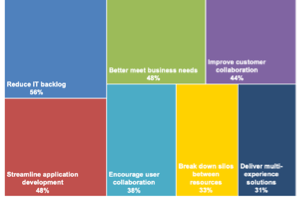 How can low-code help fill digital transformation gaps to help companies achieve the value of IoT opportunities? Jim Brown’s guest post on Siemen’s blog shows how companies can fill IoT gaps with low-code applications.
How can low-code help fill digital transformation gaps to help companies achieve the value of IoT opportunities? Jim Brown’s guest post on Siemen’s blog shows how companies can fill IoT gaps with low-code applications.
Below is a short summary, click here to read Jim Brown’s full guest post on the Siemen’s blog.
Digital Transformation Creates Opportunities
Today’s digital revolution is creating new opportunities for industrial companies. New business strategies powered by digital technologies are fundamentally changing the business landscape. Companies recognize they need to move quickly. As our Business Sustainability (and Survival) Strategies 2020 survey found, “Almost one-half of businesses (46%) have increased focus and/or accelerated digital transformation due to the pandemic.”
Digital Transformation Creates Gaps
Companies need to find ways to take advantage of the data and opportunities generated by the IoT. They need to figure out how to:
- Connect and communicate with equipment or products
- Monitor and analyze data and performance
- Notify and act on the findings
The Bottom Line
The IoT brings new opportunities and new challenges. Low-code can help companies keep up with the new demands by allowing them to move quickly while also better meeting needs and preventing rework through better collaboration with business users. Needs will change and new gaps will arise. Low-code creates the agility needed to keep up with them and profit from IoT opportunities.
The bottom line is that our study shows that “companies currently developing solutions using low-code development are over three times as likely to be able to fill digital transformation gaps “very well” than those not yet using it.”
For related research, read Can Low-Code Fill Gaps in Digital Transformation which looks at the challenges companies face today and how low-code development approaches can help.

